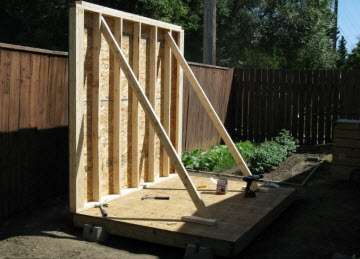My new plot has a shed on it which to my eye, seems in a sorry state and I had hoped to replace it. However on checking what criteria the new one would need to meet, I've been told I should try to repair it rather than replace it as it's only 19 years old and they've some on other sites that are 40 years old. I think the worry is that I'll give up and take the new shed with me (to my third floor flat...)
So, how do I go about repairing it? The problems are below:
Holes in roof - I know I need to refelt to fix this (even if I don't yet know how to do this).
Lean - it's on a lean that means I have to push it backwards to open the door (and even then it won't open the whole way). Is there a way of fixing this? If I hammered a stake in to the ground at the back could I push it until it met and then screw it to the stake?
Holes between the slats. We get a lot of sideways weather up here and this is the one that I'm struggling most with. There are several areas where the slats on the side no longer meet and have gaps along the length. Maybe water comes in here, maybe it doesn't? I don't know, but I also don't know how to fix it if it is one of the sources of damp inside.
And then obviously the whole lot will need a paint with some sort of preservative.
Any thoughts would be gratefully appreciated. I can see why they've suggested this line of action but I'm a bit miffed right now.
So, how do I go about repairing it? The problems are below:
Holes in roof - I know I need to refelt to fix this (even if I don't yet know how to do this).
Lean - it's on a lean that means I have to push it backwards to open the door (and even then it won't open the whole way). Is there a way of fixing this? If I hammered a stake in to the ground at the back could I push it until it met and then screw it to the stake?
Holes between the slats. We get a lot of sideways weather up here and this is the one that I'm struggling most with. There are several areas where the slats on the side no longer meet and have gaps along the length. Maybe water comes in here, maybe it doesn't? I don't know, but I also don't know how to fix it if it is one of the sources of damp inside.
And then obviously the whole lot will need a paint with some sort of preservative.
Any thoughts would be gratefully appreciated. I can see why they've suggested this line of action but I'm a bit miffed right now.




 )
)
Comment